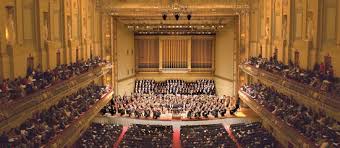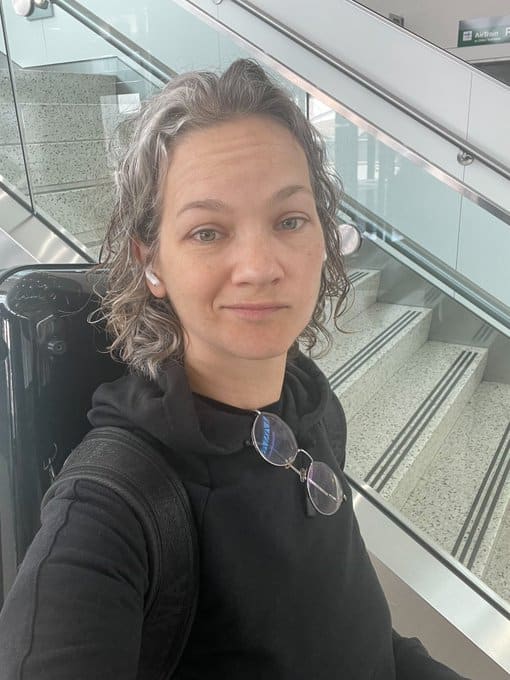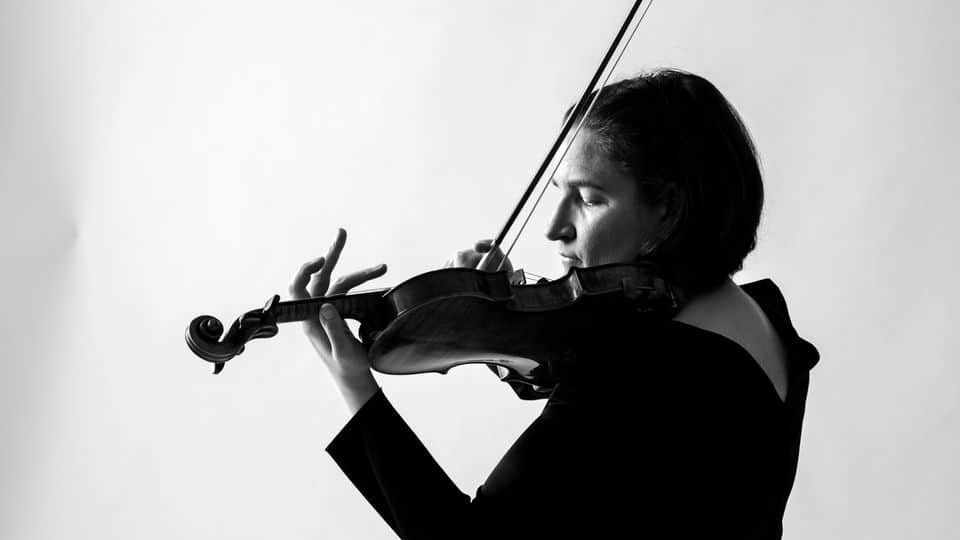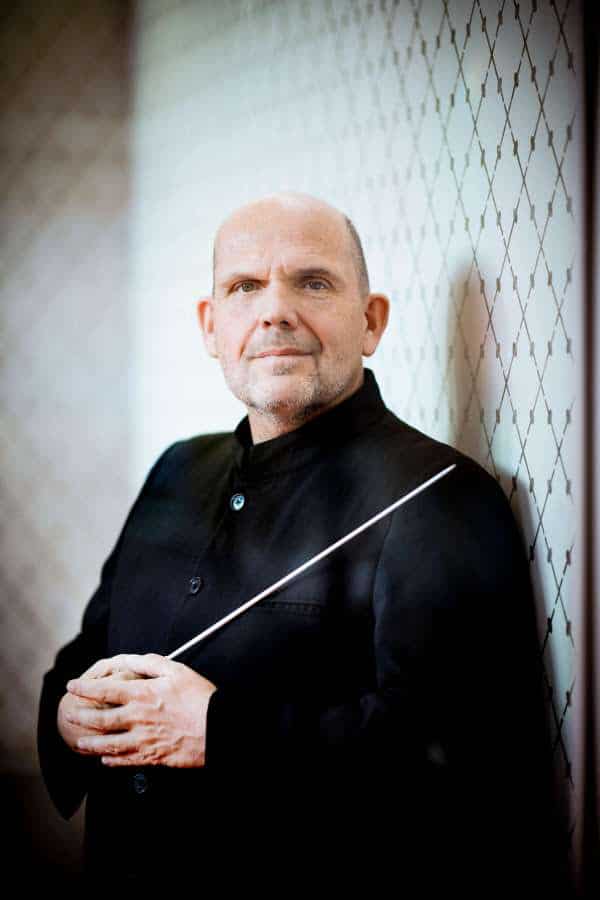Why Boston has the best acoustics in America
mainNicholas Edwards, acoustic designer for Meyerson Symphony Hall and other fine venues, relates in this new video how Boston Symphony Hall got it right.
You see it here first.


Nicholas Edwards, acoustic designer for Meyerson Symphony Hall and other fine venues, relates in this new video how Boston Symphony Hall got it right.
You see it here first.

The US violinist has posted this message on…

English National Opera has rolled out plans for…

Laura Samuel, Leader of the BBC Scottish Symphony…

The Dutch conductor, ousted after a six-year spell…

Session expired
Please log in again. The login page will open in a new tab. After logging in you can close it and return to this page.
Not only does it have the best acoustics in America, but certainly Symphony Hall is among the top 5 concert halls in the entire world – if not the top 3. And directly across the street from Symphony Hall — in the New England Conservatory, is Jordan Hall, which also has incomparable acoustics. Neither hall is very comfortable to sit in, but the unbelievable sound makes one forget the physical discomfort.
Please don’t forget Mechanics Hall in Worcester, considered one of America’s four finest halls acoustically. America’s oldest (along with Philadelphia’s Academy of Music), it’s the favorite recording venue of Yo Yo Ma.
Fascinating video, thanks!
I once had a conversation with Claudio Abbado who told me Symphony Hall was his favorite venue in America.
On tour in Boston with the Chicago Symphony Orchestra Fritz Reiner (according to the story) walked off stage after the conclusion of the first piece and exclaimed “I never knew we had a string section!”
Very interesting video. Thanks for sharing. I’ve always loved hearing music in Symphony Hall, even if the seats left a little to be desired . They really got it right the first time – the old shoebox design really works.
Now we in New York City are getting ready for the umpteenth renovation of what is now called David Geffen Hall, nee Philharmonic Hall. Back in the 70s – after the first touch ups but before the 1977 renovation – my favorite seat was one about 15 rows from the stage on the first violins’ side of the orchestra. Every time the solo trumpet entered, the sound of the entire orchestra just seemed to disappear. I have no idea how that was accomplished. Since the most recent work on the place it takes the entire brass section to chime in before the rest of the orchestra seems to disappear. Perhaps this time they will put the music first and leave the pie-shaped designs with concrete walls for something else.
The seat material is one of the reasons Symphony Hall sounds so good.
As for Geffen, it’s just too damned big.
If the seats are designed for the sound – I’ll gladly sit in them. As for Geffen (I still don’t like calling it that) I would be happy just for overall mediocrity. It’s always been a disaster – just a different one after each renovation.
I have to say, though, that after sitting BEHIND the orchestra once during a concert wasn’t a bad place for sound. I don’t think they ever did that experiment again, though. And then there was the program that was done from on the floor in front of the stage. That sounded pretty good to, but it consisted of small groups. Both were Boulez performances.
Ironically, Philharmonic Hall was planned after its designers went on a grand tour of the halls it was supposed to imitate — including Amsaterdam, Boston, and Vienna, and came back and built a junk box to reflect their junket. I think I heard it in 1963, and walked out at intermission — and never went back. I had a junior-high auditorium that was better! Never heard the opera house, but the State Theatre was pretty good. Anyway, NYC fell through the artistic bottom with that act! Then, to stick a dead pig, it raised money for years repeating its compound mistakes like a Victrola record in a rut with a dull needle! Deafened (to music and criticism), it couldn’t get its ears blown out to hear its own screams of frustration! The only thing the hall has ever been good for is the annual conventions of deaf psychiatrists and blind psychologists.
The Metropolitan Opera hall is big, and its sound is very good. I can sit in the nose bleed seats and hear very well, and see with the help of binoculars. 🙂
Philharmonic/Avery Fisher/Geffen Hall is mediocre at best. Not only is the sound lousy, but the seats are no bargain. If you’re in one of the balconies on the sides, you have to crane your neck for the entire performance, which is an obnoxious design. It is not the worst sounding hall I’ve ever been in, but it’s the worst sounding hall for a major orchestra that I’ve ever been in.
Symphony Hall is lovely, as others have said, as is Jordan Hall. There are other fine halls in the U.S., from Carnegie Hall to the Troy Savings Bank Music Hall. Geffen Hall? Feh.
All the side balcony seats in Boston’s Symphony Hall also face across the room rather than toward the stage. I’m a full-season subscriber, and my chosen seats are on the side of the first balcony, where the elevation provides more inner detail than you get sitting on the floor.
Also the stage floor. It’s beautiful old polished hardwood which many conductors have noticed contributes to the fine acoustics in Symphony Hall. Curiously, it’s a “raked” stage – higher in the back sloping down toward the audience. I’ve often wondered if that also helps. . .
The stage floor in Symphony Hall was completely replaced a decade ago. The BSO was fastidious about replicating the original materials: 3/4″ hard maple boards, tongue-and-groove, hand-nailed with square-cut nails (see http://archive.boston.com/ae/music/articles/2006/08/06/after_105_years_bso_to_enter_a_new_stage/). The results were very satisfactory. And the uneven spots—requiring shims for many players’ chairs—that probably contributed to James Levine’s bad fall which precipitated some of his other health issues, are gone with the new floor. (I was onstage in the chorus when Levine tripped and fell leaving the stage after our Beethoven Ninth.)
One can’t imagine how exquisite the acoustics are in Boston Symphony Hall if one hasn’t had the good fortune to actually attend a perfomance there.
One of the great joys of working regularly at Symphony Hall was going on stage during hours when the hall was quiet and unused, then playing my instrument to the empty rafters. While it was obviously much more reverberant when empty, it was nevertheless an otherworldly aural experience.
I had a chance to practice on the stage alone once, late at night. Checking the fabled acoustics, I found that if I made little “tick-tick” noises with my tongue, I could hear them bouncing back to me from the back of the hall. Very impressive. (Never had a chance to try that with any other famous hall, but the contrast with the venue where my orchestra was playing at the time — a huge wedge-shaped monstrosity where the back wall is almost 2 city blocks away from the stage — was, shall we say, noticeable.)
An excellent hall, no doubt. However the best in America is the Auditorium Theater in Chicago.
Mr. Edwards is right in claiming that acousticians have put undue faith in reverberation time as a measure of acoustical success or failure (until the 1960s at least). It would be a mistake, however, to summarily dismiss reverberation, as concert halls that are too dry or too live cannot be “saved” by strong lateral sound. Neither reverberation time nor strong lateral sound (nor any other single factor) is a magic bullet for good acoustics.
Mr. Edwards also unfairly pillories Leo Beranek’s work on New York Philharmonic Hall. The computer acoustical model shown in the video is not the inital design on which Mr. Beranek consulted but the final design with drastic changes to the room shape made by the architect and building committee without Mr. Beranek’s knowledge or consent. I would encourage Mr. Edwards to revise his otherwise fascinating and informative video to correct this error.
I agree that this piece unfairly minimizes the effects of reverberation, which is one of many factors that determine the sonic character and reputation of a hall. There seems to be a phenomenon in the concert-hall acoustics world wherein one factor after another is proclaimed as *the* key to a successful space, only to be replaced by another trendier one years later.
And the piece is certainly unfair to the reputation of Leo Beranek, whose work on Philharmonic Hall was undermined and undone by changes made by the client (Lincoln Center) and the architect (Max Abramowitz) without checking back with the acousticians: an overall increase in width, bowed side-walls, deeper side balconies, non-adjustable acoustic clouds, and the removal of diffusion (in the form of ornamentation in favor of flat wall surfaces). Leo Beranek told me that the most important lesson learned from the Philharmonic Hall experience was not to sign a contract that didn’t provide a direct connection between acoustician and client; his firm had been subordinate to the architect for Philharmonic Hall.
The Boston Symphony Hall’s acoustics was designed by the physicist Wallace Sabine. It is probably the first music venue the acoustics of which is decided by a scientist as opposed to architects or artists. Princeton historian of technology Emily Thompson’s very interesting and accessible book The Soundscape of Modernity (2002) documents the process leading up to Wallace Sabine’s achievement (and beyond). The changing ideas about reverberation in concert halls are particularly revealing. The successful elimination of reverberation by mathematical means in the Boston Symphony Hall is considered a sign of modernity.
Fan,
I think that if you re-read Emily Thompson’s book (not to mention Sabine’s Collected Papers) you’ll find that she and Mr. Edwards are in agreement about the responsibilities taken by Charles McKim, Wallace Sabine and Henry Lee Higginson in the design of Symphony Hall.
Sabine brought his technique for predicting reverberation to the project but did not come with an opinion on an appropriate reverberation time. Remember that Sabine had been preoccupied with rooms for speech up that point! Higginson, along with Boston Symphony conductor Wilhelm Gericke and others on the building committee, pointed Sabine towards halls they liked, particularly Leipzig’s Neue Gewandhaus, as models for the acoustics of Boston. Sabine was not able to visit the Gewandhaus to take measurements and had to rely on plans and sections to estimate the reverberation time, which he calculated to be 2.3 seconds. He missed the mark considerably – a more recent estimate by Kuhl in 1959 showed that the Gewandhaus’s reverberation time was in fact around 1.55 seconds. Happily, Sabine also under-predicted the audience absorption in Boston, so the resultant reverberation time is closer to 2.0 seconds, a time established by Leo Beranek to be “ideal” for late Romantic orchestral music.
All this to say that there was very little acoustical design per se on the Boston project. The acoustics were the product of precedent, prediction and accident!
Willem,
Thank you so much for your wonderful and very informative response. I will definitely revisit Thompson and Sabine. Meanwhile, what you just said, I believe, is of great philosophical significance in terms of the nature of knowledge. As an aspiring historian and philosopher of science, I’m keenly aware of the debate about whether scientific or objective knowledge is an understanding (and expression) of internal structure or the result of historical contingency and precedence – a distinction related to the old classification of knowledge into mechanical knowledge and historical knowledge. As a music lover, one can easily spot the corresponding debate in the history and philosophy of music. And one must note that the so-called “classical music” and modern science have overlapping timelines. I’m very glad this discussion on Boston Symphony Hall brings two things together and looking forward to learning more from you.
I absolutely disagree with Symphony Hall having the best acoustic. The sound in there depends very much on where in the hall you sit. While on stage (or close) the sounds is excellent, it drops rapidly as you move away from the stage, with the last couple of rows just being a disaster. It gets a little better on higher levels (Second Balcony) but even there the sound in the back is very undifferentiated, soupy, lacks any detail. Don’t even bother trying to understand vocal soloists or a piano recital. It sounds like playing a recording in a bathroom. What I expect from a good concert hall is to equally distribute the sound from the stage so that it almost becomes independent on where you sit. Secondly, the dynamic range should allow a solo violin playing pianissimo to clearly project throughout the hall. At the same time, the whole orchestra playing fortissimo should not result in a airplane-like deafening experience.
I have never experienced that in a ‘shoebox hall’. However, the Berlin Philharmonie comes pretty close to that ideal hall, with only the seats behind the orchestra experiencing sub-par acoustics (for obvious reasons).
Stephan,
You have identified a problem acousticians grapple with in concert hall design that is both technical and political, namely how democratic can (and should) concert hall design be? Are good acoustics possible for everyone in a hall? Does achieving great acoustics in some seats require sacrificing others?
Consider the Amsterdam Concertgebouw: listeners towards the back of the hall enjoy a luxiously rich, blended sound but listeners and performers at the front hear a totally disjointed, unbalanced orchestra. This is because the hall is unusually wide for a shoebox. Because of its width, late-arriving side wall reflections give listeners at the back a uniquely spacious sound impression but give listeners at the front distracting echoes. (For a more in-depth assessment of the Concertgebouw, check out my blog at fromthesoundup.com).
In the early to mid-twentieth century, a number of acousticians became preoccupied with achieving uniform sound in concert halls. They tried to do away with strong early reflections by creating fan-shaped auditoriums and sticking diffusers on every available surface (Bonn’s Beethovenhalle is a good example). The result, however, was mediocre sound for everyone. (See Michael Forsyth’s book Buildings for Music for more on these types of concert halls.) When you take away all of the early reflections that give impact and presence to sound, everyone suffers.
Acousticians are gradually coming around to realize that different parts of a concert hall have inherently different sonic characters. It isn’t possible to give good acoustics to all by flattening those differences, or by evenly distributing sound energy, but it is possible to build off the basic identity of each hall section. This makes for an equitable, if not equal, society of listeners.
Boston’s Symphony Hall has long been on my “must-do” list and I think it’s about time I did something about it. I’m aware of it’s high reputation for acoustics and it would be interesting to hear how it measures up to the Sala Sao Paulo which was converted from a Railway Station vestibule by the renowned acoustics firm Artec and has possibly the best acoustics I’ve yet heard in a major concert hall.
What about the much-vaunted new hall in Las Angeles — or has enough music been heard in it yet to make an evaluation?
In the Spring of 1969, I sang with a college choir during intermission at a Night at the Pops. That afternoon, we arrived and entered through the service doors, stage left. When we went out on the stage and sang the first few chords, I was amazed at actually hearing the sound travel down the empty room from us. I was aware of the Hall’s fabled acoustics, but had not been expecting anything like that!